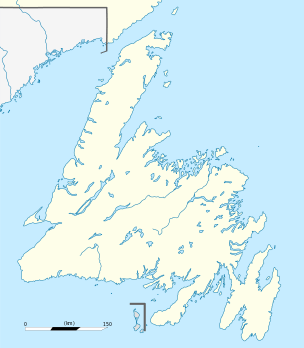Isle aux Morts
| Isle aux Morts Island of the Dead | |
|---|---|
| Town | |
 | |
 Isle aux Morts Location of Isle aux Morts in Newfoundland | |
| Coordinates: 47°35′17″N 58°58′40″W / 47.58806°N 58.97778°WCoordinates: 47°35′17″N 58°58′40″W / 47.58806°N 58.97778°W | |
| Country |
|
| Province |
|
| Population | |
| • Total | 718 |
| Time zone | Newfoundland Time (UTC-3:30) |
| • Summer (DST) | Newfoundland Daylight (UTC-2:30) |
| Area code(s) | 709 |
Isle aux Morts is a small town on the Southwest Coast of the Island of Newfoundland, with an estimated population of 600. The town is located approximately 16 km south from the Marine Atlantic Ferry Terminal in Port aux Basques.
There are two walking trails: Harvey Trail, named after George Harvey and his family (information below), and Boat Cove Trail, named for Boat Cove Pond, where residents obtained drinking water years ago. These two trails offer a great view of the harbour and the town. The Walters House museum, which is in an old-style house which shows what life was like in the past in Isle aux Morts. The house acted as the first school and church in Isle aux Morts.
Currently, the town contains one convenience store, a local bar and a school housing students from kindergarten to grade 9. During the summer season there is a museum and local cafe open. During the winter months an outdoor ice rink is maintained by volunteers. In the larger and nearby town of Port aux Basques, there are several other facilities that residents can avail of, including grocery stores, shopping malls, restaurants, a state of the art sports complex and numerous other services.
In the summer, usually late July, there is a week long festival, Ann Harvey Days commemorating Ann Harvey and her family for their brave and daring rescues of sailors stranded on sinking ships, on two different occasions. (more information below)
History
Isle aux Morts has a rich Atlantic heritage and popular coastal scenery. In the 1970s and 1980s this town, like many others in Newfoundland thrived on the fishing industry and the peak population in the 1980s was near 1200. Since the cod moratorium in the 1990s, the town has struggled and lost near half of its permanent residents because of the closing of the fish plant and many secondary sources of work.
In 1868, the first school was built and was also used as a chapel for church services. Today it is the "Walters House Museum." The local orange lodge was constructed in 1914 with free labor by a group of men who previously used the school for their meetings. The first fishery products plant was constructed in 1939 and burned down in 1943.
The first school, LeGallais Memorial, was built in 1958. In 1989, the new LeGallais Memorial school was open. In the early 2000s the highschool students from this school began being bused to neighboring Port aux Basques.
Name origin
The town is named after a formerly inhabited nearby island and is a reference to the many shipwrecks off the coast. Isle aux Morts translates from French as "Island of the Dead".
Archeology
On November 26, 1981, Wayne Mushrow discovered a very rare and working Portuguese mariner's astrolabe on a shipwreck near Isle aux Morts. The year "1628" and "Y. Dyas" are stamped on the astrolabe, indicating that it was likely made by known astrolabe maker Joas Dyas. Portuguese mariner's astrolabes are unique because they are graduated for zenith distance only.
In 1983, at the same site, Mushrow found a French mariner's astrolabe stamped with the year "1617" and the name "Adrian Holland". It is unknown whether he was the maker or owner of the astrolabe. In 2001, the Mushrow Astrolabes were designated heritage treasures by the provincial government and placed in the collection of the Provincial Museum of Newfoundland and Labrador.
Notable persons of community
The town is most famously noted for George Harvey, his daughter Ann Harvey, her brother and their dog, Hairy Man. They are known because of their bravery in rescuing sailors from two sinking ships, the Despatch and The Rankin.
A chamber opera based on the story of Ann Harvey entitled "Ann & Seamus" was written for Shallaway - Newfoundland and Labrador Youth in Chorus by Stephen Hatfield in 2007. The opera was based on the narrative poem by Kevin Major.
Pronunciations
French Pronunciation—E-lo-mor
Pronounced by Residents as—I-la-mort
See also
- List of cities and towns in Newfoundland and Labrador
- List of people of Newfoundland and Labrador
- Channel-Port aux Basques, Newfoundland and Labrador
External links
- Province receives heritage treasures
- Identifying The Astrolabe
- The Mushrow Astrolabe
- Ann & Seamus - A Chamber Opera Official Site
- Exploring Newfoundland and Labrador